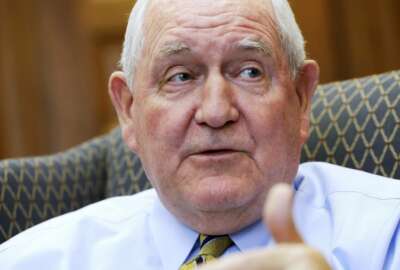
Exclusive
USDA notifies Congress, sets initial timeline to relocate 600 DC-area employees
USDA Deputy Secretary Steve Censky answered questions and tried to alleviate concerns at an Aug. 14 town hall meeting of Economic Research Service (ERS) employees...
The Agriculture Department has initiated the 30-day notice to Congress about its plans to move two bureaus outside of the Washington, D.C. metro area.
USDA Deputy Secretary Steve Censky told Economic Research Service (ERS) employees during a town hall meeting on Tuesday that the agency doesn’t need congressional approval to reorganize and a vast majority of the funding for this effort will come from the fiscal 2019 budget.
Censky said during the town hall, from which Federal News Radio obtained a recording, that there is money in the current agency budget for any 2018 planning, which mainly includes hiring a contractor to help chose a new location and plan the move.
Congress has been playing close attention to agency reorganization efforts. Lawmakers specifically highlighted this issue in the 2018 omnibus spending bill. Legislators clearly don’t want agencies to have free will as they included a provision saying agencies cannot simply cut or eliminate a specific program or office unless Congress has authorized the move in an appropriations bill.
“None of the funds made available in this or any other appropriations act may be used to increase, eliminate, or reduce funding for a program, project, or activity as proposed in the president’s budget request for a fiscal year until such proposed change is subsequently enacted in an appropriation act, or unless such change is made pursuant to the reprogramming or transfer provisions of this or any other appropriations act,” the 2018 spending bill reads. “That prior to any significant reorganization or restructuring of offices, programs, or activities, each agency or entity funded in this Act shall consult with the Committees on Appropriations of the House of Representatives and the Senate.”
It’s unclear if a relocation of an office or bureau is included under the provision. Emails to House and Senate appropriations committees seeking clarification were not immediately returned.
Censky said he hoped Congress wouldn’t become involved.
“If they wanted to micromanage what the department does, they could pass legislation, I guess. But that is what would be required there,” he said.
ERS and NIFA timeline
USDA seemed to want to use the town hall to answer questions and alleviate any concerns from ERS employees. It’s unclear if USDA also held a similar meeting with employees of the National Institute of Food and Agriculture (NIFA), which also would move out of the D.C. metro area under the plan.
A USDA spokeswoman said the agency had no comment on the town hall.
Along with notifying Congress, Agriculture released a notice in the Federal Register on Wednesday inviting states and cities to submit proposals to host the new location for NIFA and ERS, separately or jointly.
For ERS, USDA is seeking office space of up to 70,000 square feet to house up to 260 employees. About 300 employees work in the DC area for the bureau, and Censky said between 30-and-40 employees would remain in Washington to continue to work with other USDA bureaus and other agencies.
“We are in the process now and the teams … will be working with all of you over next number of weeks to identify who those people will be,” he said. “Obviously, the sooner that we can identify those positions that we plan to remain in Washington D.C., the better in terms of providing that known factor for those folks.”
For NIFA, the agency wants a facility of approximately 90,000 square feet to house approximately 360 employees.
The notice asks states and cities to provide feedback on across a number of areas to help USDA decide where to relocate. The criteria include:
- Logistics — What are the major hubs nearby, including transportation, airports and commuting options.
- Workforce and diversity — Where are the available people to employ? Can the bureaus have a steady stream of employees to choose from when hiring?
- Cost — Will the community provide benefits to the government for moving there, including reduced costs for office space or helping with the cost of building out office space?
- IT components — Specifically for ERS, will the community have the appropriate technology networks and protections required so employees can continue to do the core statistics work of the bureau?
Censky said another key criteria is the job prospects for the spouses and partners of ERS employees as well as other quality of life factors such as schools.
“We recognize that this relocation can have a big impact on employees. We plan on moving forward as expeditiously as possible so that folks know with certainty what the new location is going to be,” he said. “We will try to complete the move, to make that decision by very early 2019 on what city we will be relocated to so that folks can begin planning and begin making decisions accordingly on that. We will be working with the General Services Administration to make sure that the building has the internet capabilities and that it is built out so that it can accommodate us. Our hope, and I know this is a very ambitious timeline, would be that we could have folks begin to be relocating by this time next year. We recognize for anyone who has kids in school, getting a move done and completed before the beginning of school year is important.”
States and cities have until Sept. 14 to respond to the notice, and then USDA’s interagency team and eventually its contractor will evaluate the responses.
Seeking early buyouts/retirement authority
Several employees asked why USDA chose to relocate ERS and NIFA.
Censky said there were several reasons. First off, both bureaus are in rented space outside of the Agriculture headquarters building. He said NIFA’s lease is expiring and ERS is paying high rent.
Censky also detailed the plan for the 600-plus employees who the agency will ask to relocate. First off, he said no one who currently has a job will lose their job.
Second, he reiterated USDA asked the Office of Personnel Management for Voluntary Early Retirement Authority/Voluntary Separation Incentive Payment (VERA/VSIP) authority.
Congress hasn’t adjusted the maximum VSIP payment for civilian employees of $25,000 since 2002, but lawmakers extended the authority for $40,000 buyouts to defense civilian workers late last year. A provision in the 2019 Defense authorization bill was struck that would’ve increased the buyout to $40,000 for civilian employees.
The Office of Personnel Management included $40,000 buyout offers in a list of legislative proposals that it submitted to House Speaker Paul Ryan (R-Wis.) late in March. OPM argued the $40,000 VSIP cap would “improve the attractiveness of buyouts as a workforce reshaping tool.”
Finally, Censky described the process laid out in federal rules for relocating an employee:
- USDA will first give an employee a directed reassignment position notice to report to the new job location at a future date. The employee has 30 days to consider the request.
- At the same time, Censky said USDA hopes to be able to also give the employee the VERA/VSIP option to consider.
- If the employee accepts the reassignment, Censky said the employee will have to be at the new location within a certain amount of time, the agency will provide a relocation stipend and they will have no change in their base pay and benefits, and would receive any locality pay that comes with the new city.
- If the employee declines the reassignment and doesn’t want to or isn’t eligible for the early out option, USDA will send them a notice of proposed removal from federal service.
- The employee then has seven days to appeal. The letter of proposed removal also serves as way to receive preference as a displaced employee for other jobs across USDA or in other agencies as long as they are at the same grade level and they employee is qualified.
USDA also is moving ERS back under the agency’s Chief Economist Office, where it was until 1994.
“In some respects, there probably will be a lot that doesn’t change. A lot of the work that ERS does now, the reports and the analysis that is completed, will continue to be done. We do think that over time that there will be more focused ERS that will be better able to respond to the agencies throughout USDA,” Censky said. “From my view point and the secretary’s viewpoint, we view the group of ERS economists and their staffs as a real asset, a strategic asset that can really help agencies as they are developing programs, analyzing programs, how can they make them more effective, how can they achieve better outcomes, and I think that is something office of chief economists works across the entire department, across all agencies, right now they do that on a regular basis and we think that is something by being housed there will better help ERS to do that. It’s an alignment of our economic analysis and economic resources instead of being separated. In the long term, we think that will be more effective.”
Censky and other USDA officials promised to release frequently asked questions that will be updated often and hold monthly video town hall sessions to update employees on the progress.
Copyright © 2025 Federal News Network. All rights reserved. This website is not intended for users located within the European Economic Area.
Jason Miller is executive editor of Federal News Network and directs news coverage on the people, policy and programs of the federal government.
Follow @jmillerWFED
Related Stories







